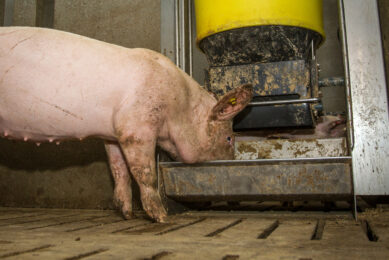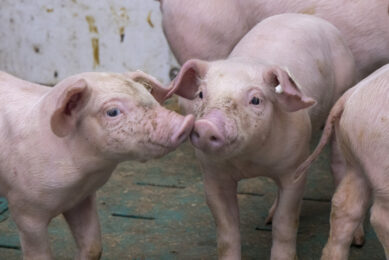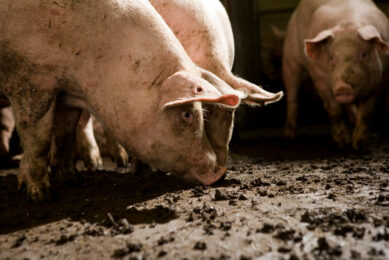Farm visit: Recreating the pig rooms according to pig preferences
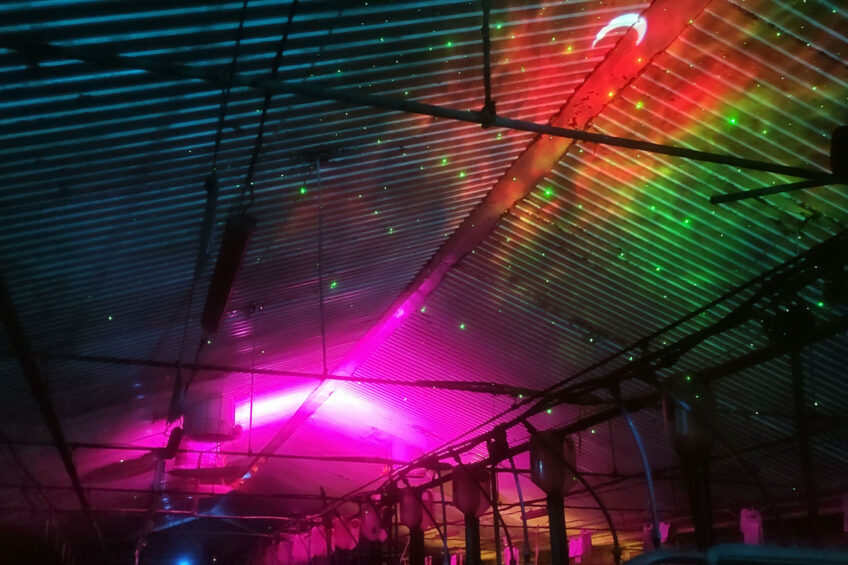
From the outside, the Polish farm Agripam may look just like a neatly maintained large farm. Yet from the inside, pigs go through an experience based on colours, smells and light. That different level of innovation, technology and care has resulted in 2 additional pigs weaned per sow per year.
Biosecurity is key for the Polish breeding-to-wean farm Agripam. The facility for 4,800 sows is surrounded by gates with disinfection mats, and entry is through a dry and wet shower before arriving in the canteen. Different coloured footwear is used between sections to further avoid risks. The buildings are meticulously maintained, which might at least partially be because half of the staff consists of women.
Apart from biosecurity, Agripam welcomes research and innovation. Perhaps that is best reflected in the workers’ mentality, as they can be seen embracing their work and the contact with the animals. It is the message that gets repeated to staff: the pig comes first. “When we enter the barn, we enter their domain.”
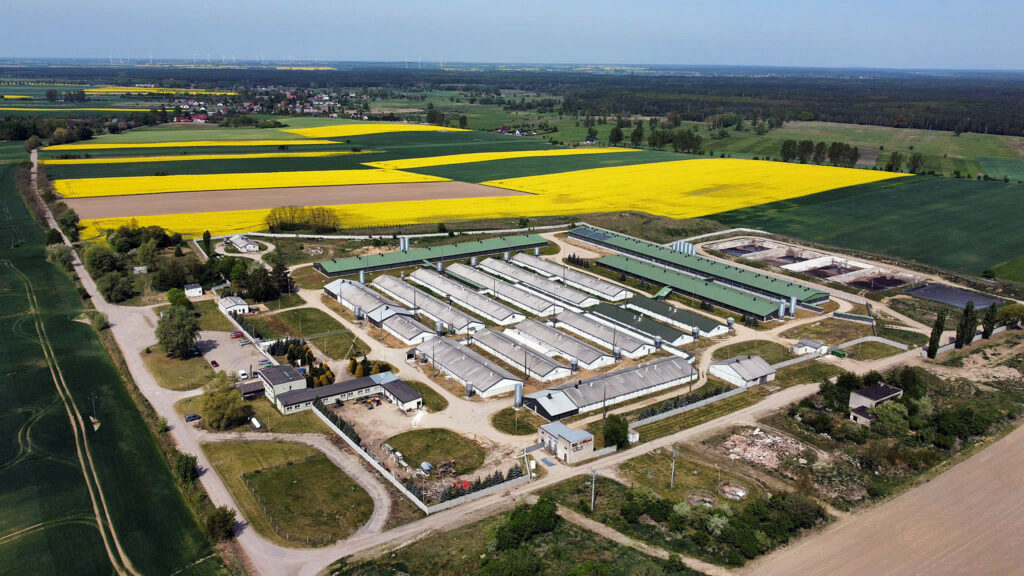
The Artificial Nature concept
Unique about Agripam is the implementation of the so-called “Artificial Nature” concept. Based on their own scientific knowledge about what animals need, the owners developed the philosophy in November 2023. They adjusted this to what they can provide within the limitations of the commercial conditions of a large-scale farm, with sows being housed in farrowing crates.
With the programme, they aim to provide a scenario in which the pigs are stimulated through their senses. For this, they have recreated ambient conditions imitating the four seasons to resemble the natural reproductive cycle in pigs. In the Artificial Nature programme, changes are made in the common farm management, in such a way that all five senses of the pigs are being stimulated. At the moment, the concept is implemented during insemination and in several groups in the sections for replacement gilts, gilt farrowing and nursery pigs.
 Vision: Light colours
Vision: Light colours
Images from the Artificial Nature rooms make it look like a top-notch dance party rather than a pig farm. The rooms have an impressive light show of a mix of colours, combined with animations of nature, such as waterfalls and forest backgrounds. The light show and projections are not random. The different colours of lighting are there to mimic the seasons. In the insemination section and early gestation, they emphasise orange, yellow and red colours to recreate autumn, which is the natural mating season, while in the farrowing section blue is the main colour to mimic spring. In the evening from 6pm to 11pm, a projector displays a night sky with a moon and stars. The use of different colours in pig barns is an active topic of research. However, Agripam is taking the lead by directly implementing it on a large scale.

 Sound: Mimicking nature
Sound: Mimicking nature
Another main difference in the experience when visiting is the sound. During the day, nature and ambient sounds are played through speakers, using sound with frequencies of 432Hz and 528Hz. Those frequencies are proven to be beneficial in humans, especially for stress reduction. During the socialising sessions in the nursery pens they use faster-paced sounds at 963Hz along with uplifting music, resulting in increased activity of the pigs, which is done to stimulate feed intake and growth. Agripam pays attention to have the sound equally distributed across the barn, using a well-distributed speaker system. The calm sound seems to have a profound effect on the pigs, especially in the farrowing room.
The pigs in the Artificial Nature rooms indeed keep calm and quiet. When entering the room, it is as if nothing happens — they all remain calmly lying down or nursing. Interestingly, during insemination, they use wild boar vocalisations, recorded in nature in the mating season. That is the pigs’ way of saying that the mating season has arrived.
 Smell: Aromatherapy
Smell: Aromatherapy
Pigs’ main sensory organ is their olfactory system, or their sense of smell, and therefore this is stimulated, as well. To mimic the smells of specific seasons, essential oils with scents related to the season are held below the air distribution channels so that they are evenly distributed throughout the barn.
 Taste: Apple juice
Taste: Apple juice
To stimulate the taste buds, gilts receive apple juice from a spray container. Instead of spraying chemicals, the container contains diluted apple juice. This is used to familiarise the new gilts with humans and to stimulate heat.
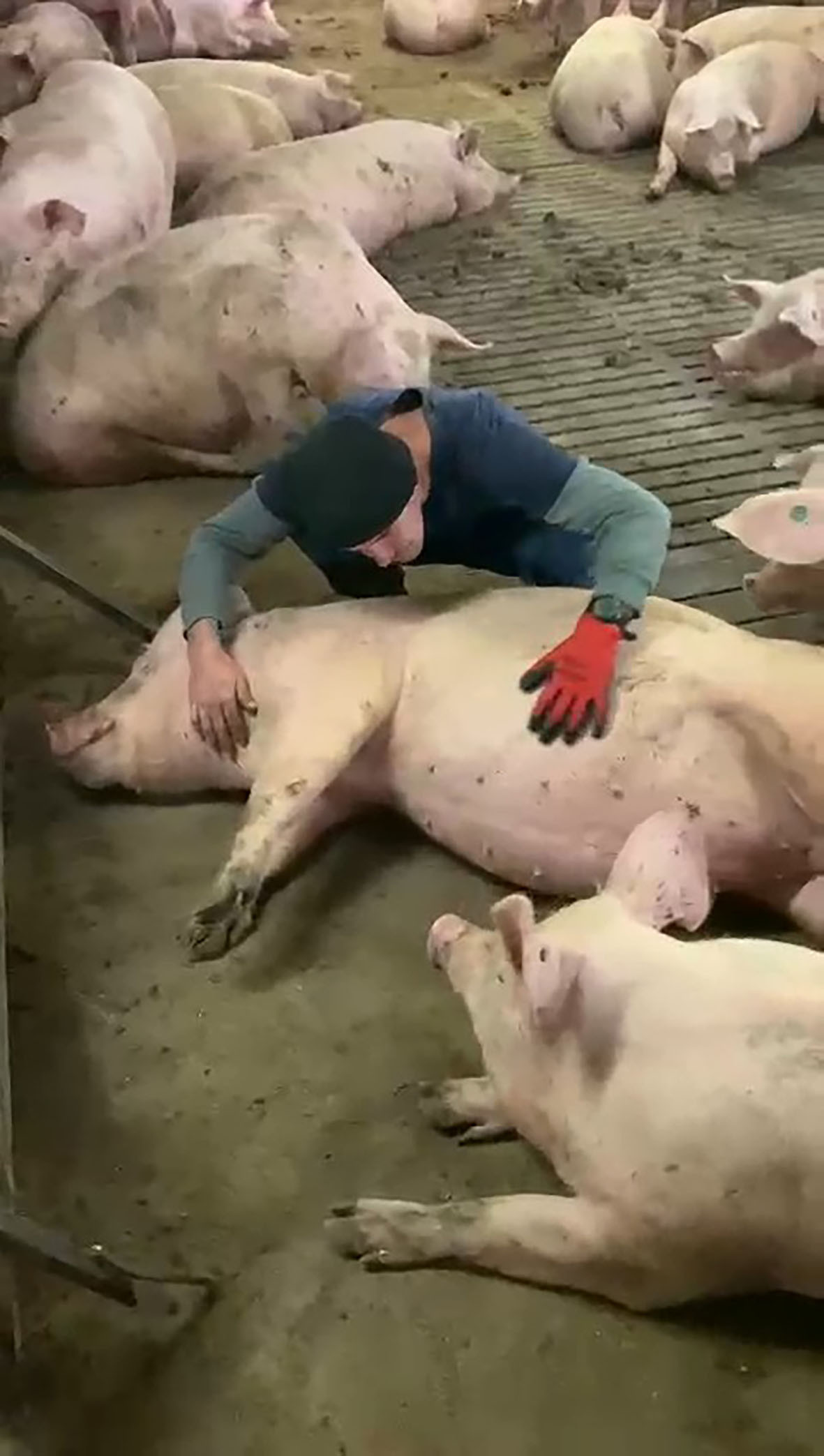
 Touch: Humans being gentle
Touch: Humans being gentle
The main investment of Agripam is in the pigs’ sense of touch. In all sections, pigs receive tactile stimulation from the farm workers. Several workers are dedicated mostly to spending time with the pigs to establish a positive human–animal relationship. During gestation and before farrowing, the new gilts receive individual attention by being touched and scratched gently. The smallest nursery pigs are hand-fed with a milk bottle and the older nursery pigs are encouraged to play. Positive human–animal interactions have been scientifically proven to be beneficial for animal welfare. The main guideline is that positive interactions should outweigh negative interactions.
Replacement gilts receive extra attention as they come from a different farm. Each gilt is approached and petted for a few minutes a day. In the farrowing unit, gilts in crates receive individual attention each day, including a belly massage, which is usually appreciated by the recipients. It is clear that they respond different to humans than normal commercial sows. They calmly lie down and reposition themselves to receive even better touch. This is not only good for the pigs but also for the humans involved.
Lechowski explains: “We have noticed that the animals exposed to the programme become more relaxed, making them much easier and more efficient to work with in everyday routines.”
Every week around 200 sows are due to farrow, of which 50 are gilts. This makes the implementation of this concept time consuming. Lechowski, Szwedowicz and Dr Morillo are positive about this extra investment and have the impression that it pays off. Longer term effects are eagerly awaited, as the gilts who have received that treatment may be easier to handle in their future farrowing.
Promising first results
At the moment, Agripam has implemented Artificial Nature in 17 groups since the start of the programme in January 2024. Because each group contains at least 50 gilts, results became clear relatively rapidly. The preliminary results so far seem very promising.
The conception rate across 17 groups of in total about 850 replacement gilts, averaged 94.17%. This is considerably higher than the world average conception rate for the first parity (ca 83%). The farrowing rate for the gilts was 93%. Gilts who received the individual care within the Artificial Nature concept had 6.5% piglet mortality in the first week after farrowing, with an average of 14.4 piglets born alive (Table 1).
Overall piglet mortality from the gilts in the Artificial Nature programme is less than 10%. In the nursery section, the piglets in the rooms with Artificial Nature, on average, had 2.5 kg more body mass gain over a period of 4.5 weeks than those in the groups without.
Lechowski emphasises: “The implementation of the Artificial Nature project has already given us an increase of two extra pigs weaned per sow per year, calculated over the last four months.”
A quick calculation shows, that if they would implement this on the whole farm, this could result in more than 21,000 extra piglets per year. They are keen to continue the implementation of the concept and to expand it to more rooms within their farm. They hope that sharing their innovation will be of help to other farmers as well as improve pig welfare.



